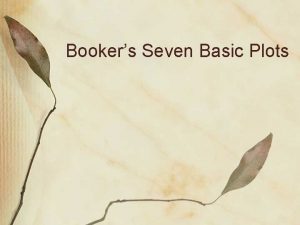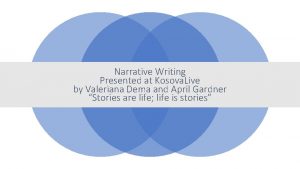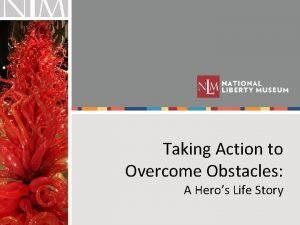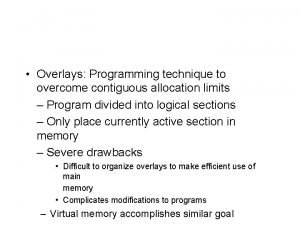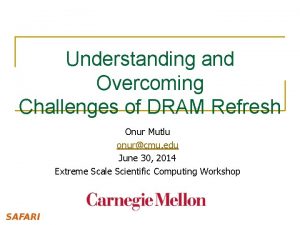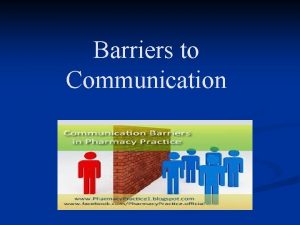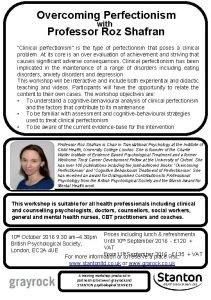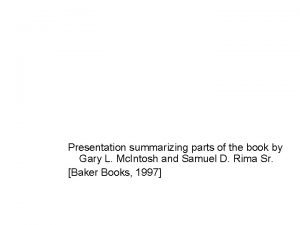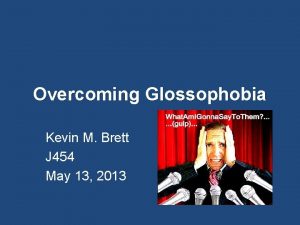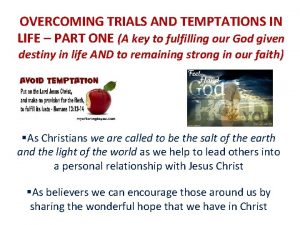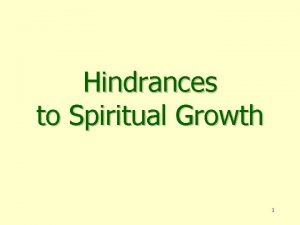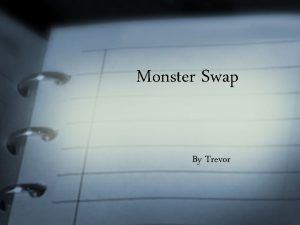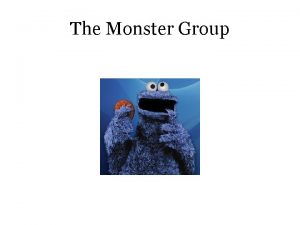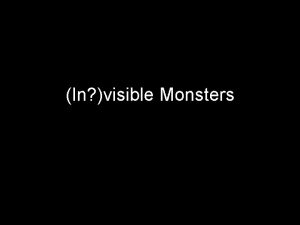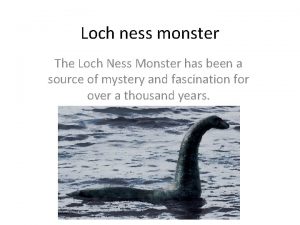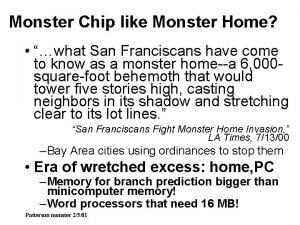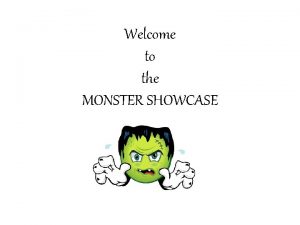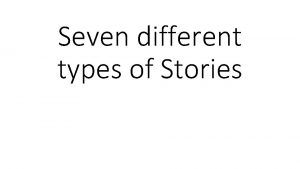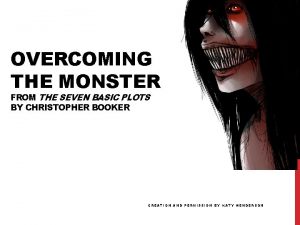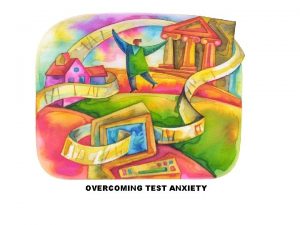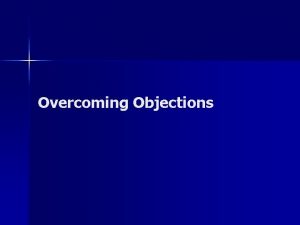s t o l Overcoming the monster p
















- Slides: 16

s t o l Overcoming the monster p c i s Rags to riches a b 7 The quest Voyage and return Comedy Tragedy Rebirth

Overcoming the monster • 1. Anticipation Stage and Call • Reader learns about the monster from afar, including its powers and reign of terror • and accepts the call to defeat the monster. • 2. Dream Stage • Hero prepares to fight the monster while it is still a comfortable distance away, although the distance between the two is decreasing. In film, a training montage usually fits in right about here. • 3. Frustration Stage • It’s here! The monster! And it’s even worse than we thought! The monster’s power is revealed in all its terrible glory, and it looks like our hero is in way over his or head.

Overcoming the monster • 44. Nightmare Stage • Battle is ON. And it’s not going well for our hero, who is pummeled by the monster. But wait, the tide of battle is about to turn. • 5. The Thrilling Escape from Death, and Death of the Monster. • Monster defeated! Hero victorious! Grateful people present hero with treasure, accolades etc

Overcoming the monster • Ancient plot type Gilgamesh David and Goliath Terminator Star Wars films. • Monsters can be abstract • fear • obsessions • inner demons, or finals week at a university.

Rags to Riches • Initial Wretchedness at Home and The Call • MC’s life is physical, mental, and/or emotional squalor. It defines them. • Forced out into the world • Experiences initial success • All their victories are short-lived because MC hasn’t matures/learned some lesson

Rags to Riches • The Crisis • Everything falls apart. • Victories stripped away The Final Ordeal MC has pull herself up by bootstraps. Must prove to self and antagonists that they are worthy Final confrontation

Rags to Riches • Examples • Cinderella, Aladdin, and The Princess and the Frog to life on the big screen. Early Harry Potter

The Quest Arrival & Frustration They’re so close! Our heroes can see the Emerald City! They’re almost there! Oh, wait, the Wizard won’t actually help them until they kill the Wicked Witch of the West. Damn. Well, that’s annoying. Our heroes still have some work to do before they actually complete their Quest. • The Final Ordeals • Now come the final tests of our heroes. Often these come in sets of three, like in Indiana Jones and the Last Crusade. • Usually our main hero is the only one who can complete the final test. Success! And then our intrepid band of heroes (or just one hero, in case everyone else is dead) makes an amazing escape from death, either by running away or by killing whatever bad guys are left. • The Goal • Huzzah! Our hero(es) have completed their quest, and get their treasure/kingdom/princess/trip home.

Voyage & return • 1. Anticipation Stage and “Fall” into the Other World • We see the protagonist in their dreary, dull, humdrum life, and then all of a sudden, something happens to escort them to the other world. 2. Initial Fascination or Dream Stage • No matter how awesome the new world is, Booker notes that the hero never feels completely at home there, foreshadowing their return. • 3. Frustration Stage 1 • This is where the dark magic starts to creep in. The hero starts feeling a little more uncomfortable, and the wonder of the world starts to feel a little more oppressive. In The Phantom Tollbooth, this is where Milo and his companions start heading towards the Castle in the Air, over the Mountains of Ignorance, and they start meeting the demons of the Lands Beyond. Chaos hasn’t completely set in, but things are looking more sinister for our hero. • 4

Voyage & return • 14. Nightmare Stage • The Queen of Hearts has unleashed her armies, Aslan has been killed on the Stone Table, and Dory is stuck in a net with a bunch of tuna. For the love of all that is good and holy, our hero better run for his life, because the shadowy element of the magical land is coming in full force. • 5. Thrilling Escape and Return • We can all breathe a sigh of relief, because the cavalry has arrived! Our hero has escaped from doom and makes the return home, having learned a valuable lesson about their home or themselves. • In addition to The Phantom Tollbooth, other examples of Voyage and Return plots include Alice in Wonderland, Finding Nemo, and most of the Chronicles of Narnia series. It’s usually a good idea to implement some character development in the protagonist over the course of the voyage, because otherwise, what was the point of the exercise?

Tragedy • Anticipation Stage • The tragic hero gets it into his or head that something is missing, and they want it. This might be power, fame, a specific love interest, or something else, but the protagonist has their motivation for the disaster dominoes that are about to fall. • Dream Stage • Hero sets out on their path to obtain their goal. Something occurs that tells the reader that this is a no-turning-back situation. • Things start to go strangely well for the protagonist. He might be well on his way down the path of evil, but no one is calling him out on it, or no one can stop him, so he proceeds further into the depths. • Frustration Stage • Right about here is where the tragic hero hits his first roadblocks. They might be small annoyances, but in dealing with them, the protagonist commits additional dark acts that seal his fate and alert the reader that the only way this can end is badly.

Tragedy • Nightmare Stage • The tragic hero’s plan is unraveling, and he can sense that an opposing force or fate is closing in. He’s increasingly paranoid and living in fear of what’s to come. • Destruction or Death Wish Stage • Our protagonist breathes his last, whether at the hands of his enemies or due to some final act of violence. Either way, his death isn’t mourned much, and the darkness that surrounded him dissipates, and there is much rejoicing. 2 • In a way, Tragedy is a much more cynical version of the Rebirth, or the flip side of the Overcoming the Monster story, since most monsters follow this trajectory. Classic examples are Macbeth and Hamlet, and a lot of films about organized crime also follow this trajectory (Goodfellas, Scarface, The Departed).

Comedy • A Comedy is a work in which the hero and heroine are destined to be together, but something is preventing them from doing so. Over the course of the story, whatever is keeping them apart is removed from the equation, usually after a great deal of increasing confusion and miscommunication, which usually results in mass hilarity. In the end, the confusion is cleared up, the bad guy is punished, and everyone gets married. • The structure is less rigid than the other six plot types, but for the most part there are three acts to the story. • The “Shadow of Confusion” • We’re introduced to the hero and heroine, who are clearly marked as destined to be together (along with possibly a few emerging beta couples), but they’re being separated. This could be physical separation (maybe they haven’t met yet), or emotional separation. • Either way, there’s confusion, miscommunication, and frustration, and the designated couples aren’t hooking up.

Comedy • It Gets Worse • The confusion previously mentioned gets even more convoluted. The darkness separating everyone is at its thickest, and the tension for the characters is at its peak. Things are going disastrously 1 for our hero and heroine. • The Confusion is Lifted • Someone or something explains the misunderstandings, all the characters breathe collective sighs of relief, weddings are arranged, and the bad guy is either punished or repents in time for the engagement party. • The key in Comedy is the execution and transition between the stages. Also, it’s important to keep in mind that Comedy in this definition isn’t necessarily funny; the name just indicates that everyone lives happily ever after. But as anyone who has seen Singin’ In the Rain or read The Importance of Being Earnest can attest, confusion is a great mine for humor.

rebirth • rebirth stories generally focus on villain protagonists who redeem themselves over the course of the story, after spiraling deeper into villainy and meeting a redemption figure. Redemption figures usually come in the form of a child or the protagonist’s other half, and they serve to remind the villain-hero what compassion or love feels like. They also help the villain-hero see what the world alignment is actually like, instead of the warped perception that the protagonist has that has given them the proclivity towards villainy. • The Structure of the Rebirth Plot Type • A young hero or heroine falls under the shadow of the dark power. • For a while, all may seem to go reasonably well. The threat may even seem to have receded. • Eventually the threat returns in full force, until the hero/heroine is seen imprisoned in the state of living death.

rebirth • This continues for a long time, when it seems like the dark power has completely triumphed. • But finally comes the miraculous redemption, either by the hero (if the imprisoned figure is the heroine), or by a young woman or child (if the imprisoned figure is the hero). • A Christmas Carol is probably the best-known example of a Rebirth story, with Scrooge as the villain-hero, and the three ghosts as redemption figures. How the Grinch Stole Christmas is another example (a lot of holiday stories, it seems, fall under this umbrella). Basically, most stories where the hero is morally ambiguous and does an about-face by the end of the story are Rebirth plots.
 Overcoming the monster examples
Overcoming the monster examples Writing a narrative about overcoming a challenge
Writing a narrative about overcoming a challenge Scripture about overcoming adversity
Scripture about overcoming adversity All the blocks you want
All the blocks you want Coalescing holes in operating system
Coalescing holes in operating system Overcoming challenges essay
Overcoming challenges essay What is communication barriers
What is communication barriers Perfectionist scale
Perfectionist scale Overcoming the dark side of leadership
Overcoming the dark side of leadership Overcoming glossophobia
Overcoming glossophobia Overcoming trials and temptations
Overcoming trials and temptations Overcoming life issues
Overcoming life issues Overcoming barriers to employment
Overcoming barriers to employment Hindrances to spiritual growth
Hindrances to spiritual growth Các môn thể thao bắt đầu bằng tiếng bóng
Các môn thể thao bắt đầu bằng tiếng bóng Sự nuôi và dạy con của hổ
Sự nuôi và dạy con của hổ điện thế nghỉ
điện thế nghỉ
